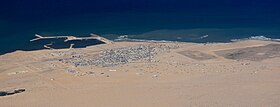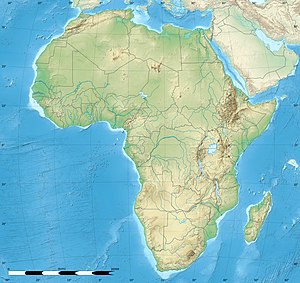Tarfaya
طرفاية ⵟⵔⴼⴰⵢⴰ | |
|---|---|
 Tarfaya skyline | |
| Coordinates: 27°56′22″N 12°55′34″W / 27.93944°N 12.92611°W | |
| Country | |
| Region | Laâyoune-Sakia El Hamra |
| Province | Tarfaya Province |
| Population (2014) | |
| • Total | 8,027 |
| Time zone | UTC+0 (WET) |
| • Summer (DST) | UTC+1 (WEST) |
| Website | http://tarfaya.info |


Tarfaya (Arabic: طرفاية - Ṭarfāya; Berber languages: ⵟⵔⴼⴰⵢⴰ) is a coastal Moroccan town, located at the level of Cape Juby, in western Morocco, on the Atlantic coast. It is located about 890 km southwest of the capital Rabat, and around 100 km from Laayoune and Lanzarote, in the far east of the Canary Islands.[1] During the colonial era, Tarfaya was a Spanish colony known as Villa Bens. It was unified with Morocco in 1958 after the Ifni War, which started one year after the independence of other regions of Morocco.[2]
Tarfaya is the capital and main town in the Tarfaya Province, and counts a population of 8,027 inhabitants according to the 2014 census.[3] Although founded in the twentieth century, the city has a big historical symbolic in the Moroccan history, dating back to the era of the Green March in November 1975.[4]
The region of Tarfaya has been linked to relations with foreign powers, following several incursions conducted at its coasts (Spanish, Portuguese, British and French). This blending gave the city a special cultural dimension in its history. The famous French writer and aviator Antoine de Saint-Exupéry (1900-1944) lived in Tarfaya for two years (1927-1928) before writing his masterpiece The Little Prince that was later translated to more than 300 languages and dialects.[5][6] He served as station manager here during his career as an airmail pilot.[7] In 2004, the Antoine de Saint-Exupery Museum was opened in Tarfaya.
Tarfaya is home to a number of economic projects, including the largest wind farm in Africa, called Tarfaya Wind Farm,[8] and Casamar, also known as Port Victoria, that was founded by the Scottish trader and traveler Donald McKenzie in 1882.[9] It is the meeting area of Atlantic coast with stretching sand dunes.
Sebkha Tah, the lowest altitude point in Morocco (55 meters below sea level[10]) is located in Tarfaya province. Tarfaya is also the closest city to the Khenifiss National Park, added to the UNESCO World Heritage Tentative list,[11] an ecological site home to hundreds of different kinds of migratory birds each year. It is estimated that more than 20,000 birds from 211 different species breed, nest and feed regularly in the park.[12]
- ^ "World Gazetteer website".[dead link]
- ^ "Decolonisation".
- ^ "RGPH 2014 | Téléchargements | Site institutionnel du Haut-Commissariat au Plan du Royaume du Maroc".
- ^ "Moroccan "Green March" Converges in Tarfaya | History Channel on Foxtel". Archived from the original on 2018-11-13.
- ^ "'The Little Prince' becomes world's most translated book, excluding religious works". 7 April 2017.
- ^ Shattuck, Kathryn (3 April 2005). "COVER STORY; A Prince Eternal - The New York Times". The New York Times.
- ^ "L'AÉROPOSTALE (1927-1932) | Antoine de Saint Exupéry".
- ^ "Africa's biggest windfarm sparks controversy in the desert". TheGuardian.com. 22 November 2016.
- ^ "MWNF - Sharing History".
- ^ McCoy, Lisa (2014-11-17). Facts & Figures About the Middle East. ISBN 9781633559448.
- ^ "Lagune de Khnifiss".
- ^ "::: Haut Commissariat Aux Eaux et Forêts et à la Lutte Contre la Désertification:::". www.eauxetforets.gov.ma. Archived from the original on 2014-02-25.

